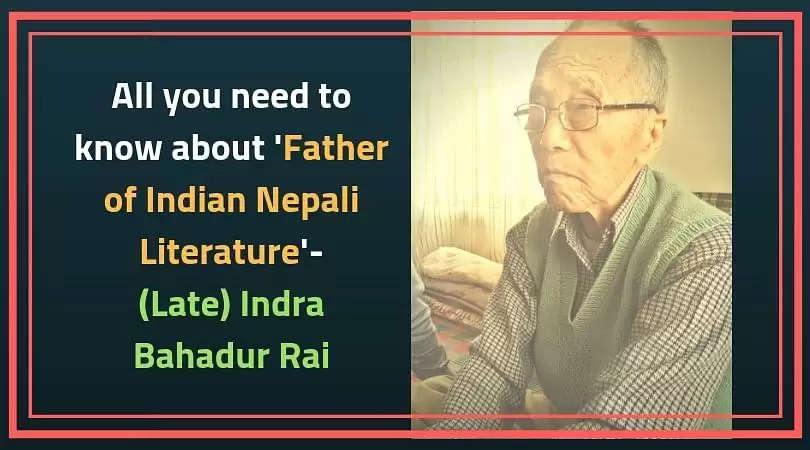All you need to know about ‘Father of Indian Nepali Literature’- Indra Bahadur Rai

TNT News Desk | November 18, 2018
Indra Bahadur Rai was an Indian Nepali writer and literary critic from Darjeeling, India. I.B. Rai was one of the most prominent and best known writers in the Nepali language. He is the author of 13 books—apart from the novel Aaja Ramita Chha—spanning the genres of short fiction, memoir, literary criticism and drama.
DID YOU KNOW This place in Northeast India is named after a missing Nepali girl!
He is credited with introducing fresh modernist aesthetics of the 'Tesro Aayam' (third dimension), as theory and in practice to Indian Nepali literature, and also played a major role in having the Nepali language officially recognized by the 8th Schedule of the Indian Constitution, in 1992.
A crisis within crisis: The fault line of India's longest statehood demand- Gorkhaland Movement
I.B. Rai entered the field of Nepali literature around 1950 when he started publishing literary criticisms in different journals such as Aadhar, Bharati, Diyo, Diyalo, and Roop Rekha. His first novel Aaja Ramita Cha was published in 1964. After that, he entered the field of short stories. His first story was published in 1959. His first book Vipana Katipaya, a collection of thirty short stories published in 1960, had a great influence on Nepali literature, especially on the genre of short stories. From 1963 onwards, he was a prominent figure in the dimensional literature movement, which is known as Aayameli Andolan in the history of Nepali literature. He, along with Ishwor Ballav and Bairagi Kainla, searched the unexplored realms of Nepali literature. They successfully added a third dimension – Tesro Aayam – to Nepali literature.
On being an Indian Gorkhali or a Nepali in Northeast India- the identity crisis continues!
One of the most well-known modern authors of Nepali literature, Indra Bahadur Rai's major works are included in the syllabus of many universities for those studying Nepali in India. He has been an active writer for over 60 years and has received the Sahitya Akademi Award (for his work Nepali Upanyaska Adharharu), Jagadambashri Puraskar and Agam Singh Giri Smriti Puraskar.[1][2] Rai is a very diverse writer and uses a wide range of literary styles that incorporate both traditional as well as modern techniques in his works. The texts he has written deal with a range of topics, from small private whimsies to key historical events, making each document a unique forceful piece of literature. According to Prem Poddar, the writings of I.B. Rai, which reflect the heritage of the Gorkha/Nepali nation and national identity, can be interpreted in two different ways:
"As I see it, Rai's reflections on the Nepali language, the Gorkha/Nepali community, and his own writing practice can be read in two ways. The first is in terms of telos: that writing will strengthen the nation or ethnie. The other way is the more troubled interrogative reading that raises the same questions of cultural identity, through textual elisions and ambivalences inter alia, about writing and the Gorkha/Nepali community. I raise the possibility, and vacillate between, both kinds of reading in this introductory essay, but the very act of vacillating veers me towards the latter."[3]
A selection of his short stories were translated into English in 2009 as Gorkhas Imagined: Indra Bahadur Rai in Translation.
Rai is also the recipient of the Sahitya Akademi Award, the Jagadamba Shree Puraskar and the Agam Singh Giri Smriti Puraskar among others. Rai was an Indian national though many in India have no clue about him probably because of the language barrier. He passed away on March 6, 2018.
TRANSLATION OF HIS WORKS
A group of 30 translators are now working on the translation of 8 short stories written by him. The 3-day translation workshop christened "Indra Bahadur Rai and Translation: Taking Indra Bahadur Rai Beyond Nepali." took place from November 15 to 17.
The workshop was organised by the Translation Centre of Salesian College Sonada and Siliguri.
Several students aspiring to be translators from Siliguri (6), Sonada (3), and a total of 21 translators and faculty from Darjeeling, New Delhi, Kurseong and Sikkim participated in the 3-day workshop.
Divided into 8 groups of 3 each, the students, faculty and translators are translating 8 short stories of I.B. Rai into English, Bengali and Mizo languages.
Among short stories being translated into Bengali and English languages are: Ghasi Sanga (With the Grass Cutter) which portrays the duality of the lives of the writer in contrast to that of a grass cutter. Another popular story Kathputali Ko Mann (Conscience of a Puppet) is being translated into Bengali and English. Third story being translated into Bengali and English is called Bagh (Tiger). It deals with the lurking psychological fear of extra-marital affairs. Maharodan (The Cry) narrates people's perception of why a woman is crying. Fifth story entitled Agan Ko Ghaam Ma Laata (Fool in the Midday Sun) describes a fool who comes by author's house and his perception of the fool's disposition. Janti (Wedding Parade) narrates the adventures the groom's party faces while accompanying the bride. Seventh story Mithak Maatra (Only Myth) which talks about how older generation must make way for the new generation to survive amicably is being translated into Bengali, English and Mizo. The last story being translated into English and Bengali is called Viswa Timra Charanoma (World at your feet) which narrates author's visit to a super market to buy a shoelace.

















